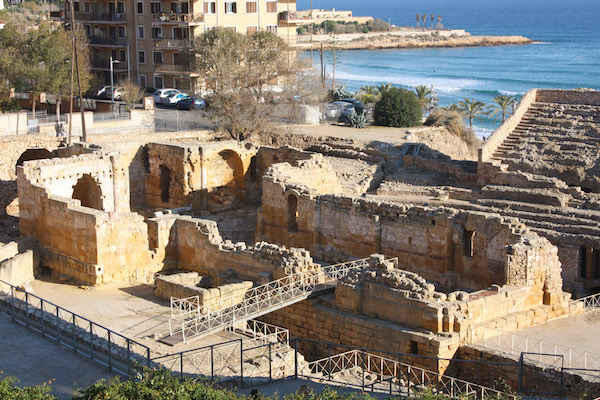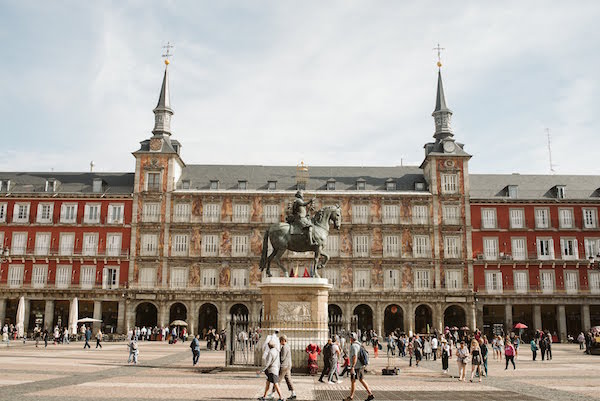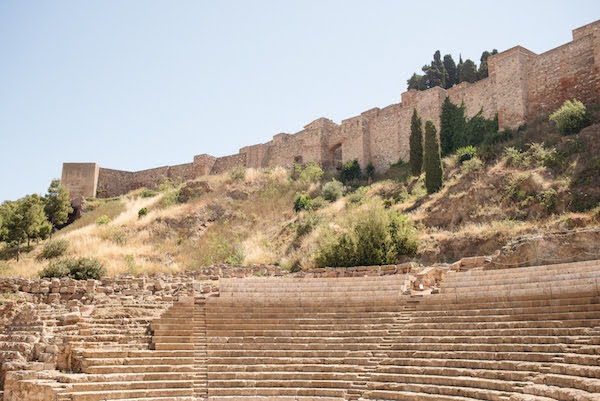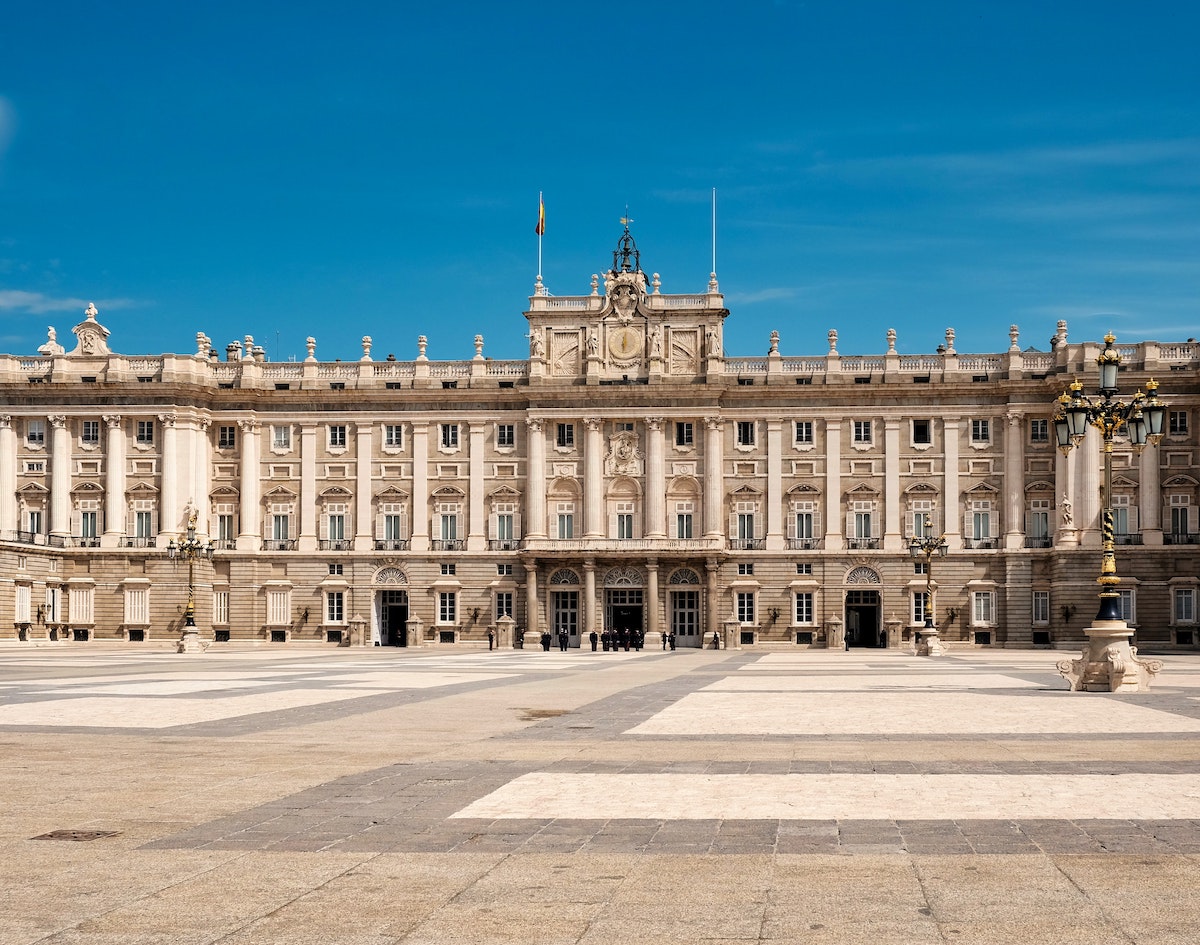This post is a part of our Spain for Everyone series. The information below was curated by our expert guides across the country. They are history lovers too, and this is their bucket list for you!
With a history stretching back millennia, Spain is a history lover’s dream come true!
The Phoenicians, Romans, Visigoths, Moors and so many more all called the Iberian Peninsula home at one point or another. As a result, Spain is full of rich history from dozens of different cultures. No matter where you find yourself in the country, you’re sure to discover history around every turn! This guide to historic sites in Spain shows you just a few of our favorite places where the past comes alive.
Alhambra (Granada)
As the most-visited tourist attraction in Spain, Granada’s magnificent Alhambra draws millions of visitors every year. People come from all corners of the world to see the splendor left behind by the Nasrid dynasty centuries ago. Constructed in the 13th century CE, it served as a palace, fortress, citadel, garden, royal residence and center of government. Granada remained the last Moorish stronghold in Spain before the Catholic Monarchs retook the city in the Christian Reconquest of 1492. Not long after that, a splendid Renaissance palace was built on the Alhambra’s grounds as well. As a result, this single magnificent complex encompasses two rich areas of the city’s history.
Today, visitors to the Alhambra mainly come to see the Nasrid Palaces. With its colorful tiles, high arches and breathtaking attention to detail carved into the marble, the palace alone is one of the most incredible historic sites in Spain. However, there’s so much more to the Alhambra. The peaceful Generalife gardens look absolutely magnificent, especially in the springtime when the flowers are in full bloom. Climb to the top of the towers in the Alcazaba (fortress) area and take in the stunning views of the Albayzín and Sierra Nevada mountains. Finally, be sure to duck into the Palace of Carlos V to check out the two fantastic museums hidden inside. You could easily spend all day at the Alhambra!

Mezquita (Cordoba)
Towering over the Guadalquivir River and the old Jewish quarter of the city, Cordoba’s stunning Mezquita (Spanish for “mosque”) commands attention from every angle. Construction on the grand mosque began under the rule of Abd ar-Rahman I in the eighth century CE. The site had originally held a sixth-century Visigothic chapel for St. Vincent, the ruins of which still make up part of the Mezquita’s basement today. The great emir’s successors continued to expand the mosque. They heightened the minaret tower and adding a whopping 1,293 columns to support the famous red and white striped arches. Today, more than 800 have survived. In fact, when the Christians conquered the city in 1236, they found the mosque so grand and glorious that they refused to tear it down. Instead, they built their own cathedral right inside the original structure!
As one of the top historic sites in Spain, the magnificence of the Mezquita captivates and enchants visitors even today. The iconic arches inside and ornate gold touches on the exterior hearken back to Moorish glory days. Besides the cathedral, another noteworthy contribution from the Christian period is the bell tower (renovated from the original minaret after the reconquest). If you’re not afraid of heights, you can climb the 54 meters to the top and take in the stunning views of the mosque and its lovely orange tree patio.

Royal Alcázar (Seville)
Seville’s Royal Alcázar takes visitors’ breath away with its magnificent splendor of gardens and palaces. It features a beautiful combination of Christian and Moorish elements, like the Alhambra and Mezquita, but with its own completely unique feel. Abd ar-Rahman commissioned the original palace-fortress in 913 CE. Over the centuries, it has undergone numerous updates and renovations, leaving behind traces of civilizations past. The Alcázar we’re familiar with today dates back to the fourteenth century and serves as a spectacular example of Mudéjar architecture.
With its long and storied history, the Alcázar is one of the oldest European palaces still in use. It serves as the Spanish Royal Family’s official residence whenever they spend time in Seville. Thousands of visitors come from all over the world to marvel at the royal quarters and lush, luxurious gardens. Recently, it gained international fame as the filming location of Dorne in the fifth season of Game of Thrones. However, locals have known it long before then as one of the most storied historic sites in Spain.
Roman city of Tarraco (Tarragona)
One of the most iconic civilizations to ever roam the earth built an expansive colony in what is now Catalonia. The city known today as Tarragona gets its name from the original Roman moniker, Tarraco. Its location on the Mediterranean coast provided easy access to Rome, which was important due to the city’s status as the first major Roman settlement outside the Italian peninsula. The city grew exponentially after its establishment in 218 BCE. and became a key city within the empire.
While you can spot some medieval touches as you make your way through the streets of modern Tarragona, the city still features overwhelmingly Roman details. The historic amphitheater, one of just a handful of Spain that remains open to the public, dates back to the second century and once held 12,000 spectators in its heyday. Not far away is the towering Roman Circus, which once held horse and chariot races. Today, the surviving tower provides one of the best panoramic views of the city. As you explore the city, keep your eyes open for dozens more Roman ruins keeping history alive.

Plaza Mayor (Madrid)
Making your way through the winding streets of Madrid’s historic center, you’ll suddenly stumble out into a grand arcaded square surrounded by stately red buildings. You’ve found yourself in Plaza Mayor, the Spanish capital’s most identifiable square and one of the top historic sites in Spain. Built on the site of the former Plaza de Arrabal at the beginning of the 16th century, it was the site of many grisly events (bullfights, executions and more) in its early years. Luckily, today the sunny square is a much more pleasant place to visit and is the epicenter of daily life for visitors and locals alike.
The modern plaza can be considered one of the most important points in the city. It is the home of Madrid’s tourist offices and countless events throughout the year, including a picturesque Christmas market in December. While the plaza itself attracts many tourists, step out onto one of the side streets for a slice of local life. Here, you’ll be able to experience one of Madrid’s foodie rites of passage: a calamari sandwich at one of the bars near the plaza, washed down by an ice cold beer!

Alcazaba (Malaga)
As one of Malaga’s most iconic landmarks, the Alcazaba also stands out as one of the Costa del Sol’s most important historic sites. Dating back to 1057, it stands as a magnificent example of Moorish architecture. In fact, it remains the best-preserved fortress from this period in the entire country! Its military fortifications, such as turrets, arrow slits and battlements, have survived remarkably well. However, its strategic position overlooking both land and sea made it invaluable to the inhabiting armies. What makes the Alcazaba especially unique in its architecture is the use of materials from the Roman amphitheater at the foot of the structure.
Modern-day visitors to the Alcazaba remain equally enchanted by both the structure itself and the sweeping views of the Mediterranean from its heights. It also offers easy access to two more of Malaga’s important historic landmarks: the Roman Theater and Gibralfaro Castle. The theater itself is free to visit, while you can earn a discount on the castle by purchasing a combined ticket to the Alcazaba. Budget friendly and historic: what’s not to love?

Cathedral (Seville)
After the reconquest, the new Christian rulers of the city wanted to show off their wealth and power. They did so by building a grandiose cathedral in Seville between the years of 1434 and 1517 on top of what had been the mosque during the Moorish period. Church elders aimed to build a church so large and splendid that future generations would think they were mad. The result: the largest Gothic cathedral in the world (and the third largest church on the planet, too).
The exterior of the cathedral merely hints at the breathtaking treasures which lay inside. From the ornate gold altarpiece crowning the center of the main chapel to the expansive choir loft, it will astonish even those visitors who don’t consider themselves particularly religious. Don’t forget to check out the tombs of Christopher Columbus and his son, Diego, before heading up the 34 ramps of the Giralda bell tower. Once at the top, you’ll be rewarded with stunning views of all corners of the city.

Royal Palace (Madrid)
Gleaming beautifully over Plaza del Oriente, Madrid’s Royal Palace looks every bit as stunning as its name implies. However, it may surprise visitors to learn that the site was originally home to a Moorish-area fortress! The original Arabic alcázar had been around since the ninth century. It was converted into a royal residence under the rule of Charles I in the Middle Ages, but burned to the ground in 1734. Then, the splendid royal residence that is a symbol of Madrid today was built in its place.
Today, the palace enjoys a status as the largest royal palace in Western Europe, comprised of more than 3,000 rooms. It is still considered the official residence of the Spanish Royal Family and several generations of royalty have called it home. However, today’s royals don’t actually live there, opting instead to live in the Palace of Zarzuela on the outskirts of the city. The stately palace in the heart of Madrid is still used ceremoniously for official events. Visitors can enjoy access to one of the grandest historic sites in Spain on most days throughout the year.

Spanish Civil War sites in Barcelona
Less than a century ago, Spain was in the middle of a tumultuous civil war that destroyed the lives of countless citizens. Remnants of this heartbreaking time period can still be found all over the country. They are considered to be some of the most solemn historic sites in Spain. Barcelona is home to quite a few of them, including the bomb shelter Refugi 307. As one of more than 1,000 such shelters built in the city during the 1936-39 Civil War, it remains a potent reminder of the anguish and fear that the citizens of Barcelona experienced during that time. Its more than 400 meters of tunnels contain all the necessary facilities for survival. These include a toilet, water fountain, fireplace, children’s area and infirmary.
Another fascinating area left over from Spain’s Civil War overlooks the city from the Turó de la Rovira hill. Known as the Carmel Bunkers, they were constructed during the war as anti-aircraft fortifications. The setup allows for vigilant 360-degree views of the city. Large cannons were strategically placed along the edges to allow for maximum protection. After the war, the site became a sort of shanty town for decades. Barcelona’s local government made efforts to clean up the area before the city hosted the 1992 Olympics. They relocated the last of the residents living in the shanty town. After that, the area was essentially abandoned for the better part of a decade. Today, it’s enjoying a revival as one of Barcelona’s best-kept secrets and a particularly great sunset spot.

Mota Castle (San Sebastian)
Perched between the city and the sea, San Sebastian’s Mount Urgull offered an ideal location for a military structure. In fact, it was used as such from the city’s earliest days. Ancient paths and fortifications are still visible on the hill. However, it reached even greater importance at the beginning of the 12th century. At that time, King Sancho of Navarra ordered the construction of walls and a fortress on the site.
That fortress became Mota Castle, which would become a key military site over the next few centuries. It was the site of the French takeover of the city in the eighteenth century. It also played an important role in the Carlist wars.
Visitors to the castle nowadays won’t have to worry about getting caught in gunfire. The castle hasn’t been used for military purposes in over a century. Today, Mount Urgull is a public park, and Mota Castle houses a fascinating museum known as Casa de la Historia. As one of San Sebastian’s top museums and one of the best historic sites in Spain, it will transport you through 800 years of the city’s rich history.
You’ll learn about the social, economic and urban development of San Sebastian. Plus, you’ll discover the most important festivals and traditions that the Basque people have celebrated for centuries.
Noteworthy museums
We can’t talk about historical sites in Spain without mentioning a few of the dozens of museums that put history into context. No matter where you find yourself in the country, you’re sure to find a museum (or several!) that will help history come alive.
Madrid
The San Isidro Museum (Plaza San Andrés, 2) will show you the fascinating origins of the city dating back to ancient times. The museum features thousands of years of history. Particularly noteworthy are the examples of the old city walls from both Moorish and Christian times. Similarly, the Madrid History Museum (Calle de Fuencarral, 78), housed in a gorgeous Baroque building, features more than 60,000 objects dating as far back as Madrid’s establishment as the national capital in 1561. The best part? You can visit both for free!
Another noteworthy museum in Madrid for history lovers is the National Archaeological Museum (Calle de Serrano, 13). It offers visitors the chance to view one of the most exclusive collections of items spanning from ancient times until the 19th century. Particularly noteworthy is the Dama de Elche. This famous bust of a fourth-century BCE woman is one of the most famous sculptures in the world and is valued at 15 million euros!
Headed to the capital? Join us on our Madrid in a Day with Royal Palace, Churros Tasting, and Prado Museum. Experience the essence of the city in just one day – a perfect blend of history and sweet indulgence awaits!
Barcelona
The Catalan capital is also home to a City History Museum (Plaça del Rei, s/n) of its own. Located in the Gothic Quarter, it takes visitors back in time through Barcelona’s rich history, starting with the Romans. In fact, it’s even home to the largest Roman excavation—the ancient city of Barcino—outside of Rome itself!
Many of the ruins make up part of the museum’s permanent exhibition area. All of this, plus more than 35,200 artifacts, are housed within the walls of a splendid Gothic palace. Visitors can access the museum for free on Sunday afternoons. The rest of the time, it will only set you back €7 for unprecedented access to history.

Seville
Seville has long enjoyed a status as one of the most important cities on the Iberian Peninsula. Today, it preserves its rich history in the form of several museums. The Seville Archaeological Museum (Plaza América, s/n) was founded in the nineteenth century to house a collection of artifacts from the nearby Roman settlement of Italica. Today, it also holds countless treasures from prehistoric times, the Phoenician era, the Moorish period, the Middle Ages and so much more.
Another noteworthy building, the Archive of the Indies (Avenida de la Constitución, s/n), houses all of the documentation related to Spanish explorers’ journeys to the Americas. Entrance is free and allows you access to the building where more than 43,000 files from this historic period are carefully stored.
Whether you’re a history enthusiast or not, our Alone in the Alcazar: Exclusive Early Access Tour is a great way to see and learn about one of Seville’s most iconic landmarks. Escape the crowds and savor the grandeur with our VIP-level early access experience.

Malaga
As one of the newer history museums in Spain, the Museo de Malaga (Plaza de la Aduana, 1) only opened in 2016. However, it has quickly made a name for itself as a must-see for history buffs along the Costa del Sol. It brought together two formerly separate museums: the Fine Arts Museum and the Archaeological Museum.
The incredible collection makes it one of the largest museums of its kind in Andalusia. Housed in the old Customs building, it is a true testament to Malaga’s rich history from prehistoric times to the modern day. EU residents can get in for free, while entrance costs just €1.50 for everyone else.
Want the perfect blend of food and history right here in Madrid? You’ll love our Tapas, Taverns & History Tour!